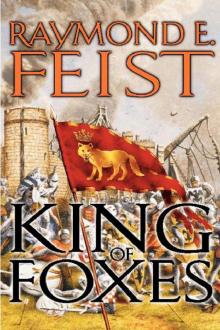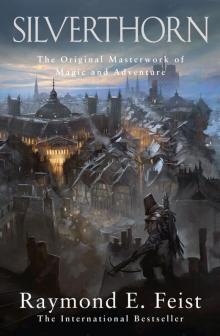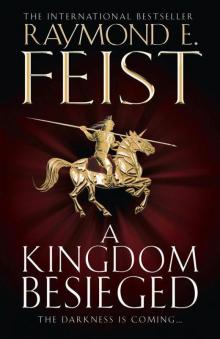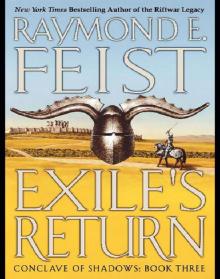- Home
- Raymond E. Feist
Midkemia Page 3
Midkemia Read online
Page 3
After securing that position, the original keep tower was built—now the northwest corner of the Duke’s castle—and a year later what became known as the Southern Campaign began. Carse was the largest of the three Keshian enclaves to fall to Duke Borric’s grandfather and was a prosperous trading port compared to Tulan. The major export to the Empire was hard oak, a species that didn’t exist in the Empire of Great Kesh and one superior for shipbuilding.
To my unschooled eye, Carse was a beehive, people swarming everywhere, an impression I carried with me for years until visiting larger cities. There were a half-dozen good-sized ships in the harbor, whereas Crydee rarely had more than one at a time in port. I learned later these were still small ships by Kingdom standards, coasters that rarely braved deep waters.
I had yet to undertake that portion of my training concerning boats and their handling, so what I recall is sketchy but I do remember a busy port, with many barges and boats carrying cargo to and from the city.
Carse was my first venture away from home, along with a wainwright named Francis, his apprentice, and three other boys. We were delivering two newly made wagons to a farmer who was meeting us in Carse. I and another boy took turns driving one small wagon, while the other pair of boys drove the second. The apprentice, a quiet lad named Teddy, moved from wagon to wagon, so we all had his tutelage, as well as some time on the big wagon with Master Francis.
I was looking forward to spending the night in an inn with hot food and stories from travelers of far-flung lands, but we housed in the stable with Teddy while Master Francis partook of the inn’s comforts and departed the next morning. I was disappointed more over not being permitted to explore Carse than spending a night on damp straw.
Still, it had been my first taste of adventure and for a lad of nine I had not disgraced myself in driving a team. I was well satisfied, though I knew before the journey was half over that I had no desire to be either a teamster or a wainwright.
My second journey was by boat, down the coast to Tulan, to carry messages to the Baron of Tulan from my lord Borric. It was here I discovered I had neither any aptitude for sailing nor love of the sea. The water was choppy and while I didn’t get seasick, neither was I fully at ease. The work was hard; I was the youngest lad aboard and the smallest, but thankfully I endured no task alone, so things were done in good order. My hands were already calloused but the ropes—stays and sheets as the sailors call them—burned my hands, and by the time we reached Tulan my palms were raw. I was told salt water would toughen them.
Tulan was fascinating once we dropped anchor, for it was originally a fortress on a rocky isle in the mouth of a large river. To reach Tulan, you sail along the coast, then turn toward a headlands and beat against the tide and wind into a small bay, not really more than a deep inlet, to a series of small islands that cluster there.
The original fortification was designed as a defensive position against any incursions from Kesh attempting to retake Bosania from the Kingdom. Initially there had been a hastily erected wood-fenced compound behind a good-sized dock and three ships anchored a short distance away. These composed the entirety of the Duke’s fleet and were the only Kingdom ships beyond the Straits of Darkness.
By my first visit to Tulan, the old wooden fortification had been supplanted by a full-sized stone keep, including stables and yard, occupying the entirety of the island, save for the docks. As a result, the community of Tulan had sprung up on the nearby islands, many of them connected by bridges, most by dock and boat, and a unique town had evolved.
When weather permitted, the passages between islands—naturally occurring parts of the estuary supplemented by a handful of man-made canals—were thronged with boats and barges moving goods and people from island to island. I found the entire tableau fascinating. It was late spring so the weather was warm and the breezes gentle, and everything about this town felt exotic.
We spent three days in Tulan before departing back to Crydee, and rather than a stable as I endured two years before, we were allowed to sleep aboard the boat. We had meals fetched to us by servants of the Baron, and I could only imagine what life in this watery town would be like.
Perhaps someday I will return to Tulan should time permit, just to take a look around. The sailing home was uneventful but tedious as we had to sail away from the coast against the wind to avoid the rocks. That meant long tacks out to sea, then short runs back toward the coast. It took us six days to return compared to three getting to Tulan, but at least by then my hands had toughened enough so the ropes no longer hurt.
My stint learning the hunter’s trade took me through the woodlands surrounding Crydee. Martin Longbow, Duke Borric’s son and now Duke after his father, was unrecognized then and served as the Duke’s Huntmaster. He was a mysterious figure to we boys of the keep, coming and going like a shadow. His skills at hunting were matched only by those of the Rangers of Natal from the Free Cities, and exceeded by the elves, though even those elves with whom I spoke regarded Martin highly.
The woodlands within two days’ hike around Crydee were rich with mystery and magic for boys away from family, stalking game and wondering if we possessed the skills and temperament for the calling. The Duke’s hunters were tasked with more than simply shooting deer and bringing meat back; they sought out poachers who were hunting the Duke’s land without permission, as well as kept an eye out for any signs of incursion from the Brotherhood of the Dark Path, bandits, trolls, or goblins. They also watched for signs of diseased elk, deer, or other creatures that might contaminate the duchy’s cattle, sheep, or goats.
I was paired with a lad named Elkins, son to a cobbler, for Megar would not spare both Tomas and I from the kitchen at the same time. He always complained the lads sent there to serve and learn were more hindrance than help, and in part that was true. More than one stew had been oversalted or bread taken too soon from the oven by an overeager boy serving his first few days in the Duke’s kitchen.
Elkins appeared to have no talent for hunting, but I fancied my skills better than average. I could hit what I was aiming for with a bow often enough, if the target was a tree that wasn’t moving, but though it sounds immodest, I was deadly accurate with the sling, and I presumed that skill would somehow translate to improving with a bow should I be given the chance.
So I ranged within the relatively safe environs of the woods around the duchy. To the south was the Green Heart, a forest so dense no one could find a path to the southern pass over the Grey Tower Mountains without skilled trailbreakers and guides. Within the dark glades of that massive forest lived all manner of beings hostile to humans. A particularly aggressive group of clans of the Brotherhood of the Dark Path, mountain trolls in the foothills of the mountains to the east, also roamed the eastern side of the forest, and bands of goblins also called the Green Heart their home.
When the Choosing finally was upon me, I stood in the courtyard of the Keep, before the duke and his family, fearing, like all boys, that I might not be offered any apprenticeship. Then, against reasonable expectations, Kulgan, my Lord Borric’s magic adviser, chose me as his apprentice. At that moment, I was relieved to have any calling, not understanding how magic would become the heart of my existence.
My father glosses over a significant event in his youth, one that gave him his first advancement in his station. It is what first marked him as an adept at what is now called Magic of the Greater Path.
He was tasked to accompany Princess Carline, Duke Borric’s daughter, on a picnic as her guardian, and they were set upon by a pair of lowland trolls who would otherwise have killed both of them. The stress of that encounter caused my father to reach deep within and discover power previously unsuspected, and in an unprecedented act, he destroyed the trolls with a magic spell. It was a watershed moment in my father’s life. It saved them both, and as a reward, my father was elevated to the rank of Squire and given a place in the Duke’s household.
Pug Destroys the Trolls
Entry, the
Third
IT IS WELL KNOWN BY MANY THAT IT WAS TOMAS AND I who discovered the wrecked Tsurani galley on the shores below Sailor’s Grief, and encountered the dying Tsurani warrior. That began a series of events, undertaken by Lord Borric to ensure the safety of the Far Coast from what was perceived as a dire threat.
The Elf Queen and her court came to Crydee, an event unprecedented, and after that meeting, His Grace determined he must personally carry word to Prince Erland in Krondor, for should the invaders come in force, Crydee was ill prepared to counter an invasion.
Our journey began with the decision to travel through the Green Heart, striking for the southern pass through the Grey Towers, as the northern pass was already visited by snow and would be impassable by the time we reached it.
In the Green Heart we were attacked by the Brotherhood of the Dark Path, barely escaping with our lives after having lost some number of brave soldiers who defended their Duke, Prince Arutha, me, and Tomas. Kulgan, my master in magic, confounded their pursuit with a spell of enveloping fog, allowing us to find shelter in a cave in the foothills.
We were attacked in the cave by wandering goblins who bore signs of recent struggle, a harbinger of Tsurani incursion into the Grey Towers, though at that time we did not know this. We were found by Dolgan, leader of the dwarves in the Grey Tower Mountains. He agreed to guide us through ancient and abandoned mines leading from one side of the mountain range to the other, most notably an ancient mine known as the Mac Mordain Cadal, one spoken of in hushed tones by the dwarves and reputed to be home to ancient spirits and other horrors.
Reflecting on this journey years after, I recognize it was a unique and fascinating part of the journey, but at the time I was too overcome with worry to appreciate it. The tunnels of the mines were long and dark, emptying into large chambers where rich veins of ore had been removed by the dwarves centuries before. For all its dark and gloomy aspect, within the mines exists one of the most wondrous sights I have ever beheld.
In the heart of the mines is an ancient waterfall, one shifted underground by an earthquake ages before. It courses through rock and percolates down to where it again gathers as a torrent, and within a vast cavern as high as any tower at Crydee, it spills into a deep chasm. The unique thing of it is that the water has leached minerals along the way and when the light of lanterns shines on it, the falls alights in rainbow hues, glimmering and shimmering, with flecks of gold and silver throughout. More, when the lanterns we carried were shuttered, the water continues to glow with a spread of colors that in my youth seemed magical in nature.
Both Dolgan and Kulgan explained to me later how the minerals come to interact with light, but there are moments in life where the wonder of ignorance is a little more gratifying than the clarity of understanding; this was such a moment, perhaps the first such in my life.
I have witnessed great and majestic sights, unleashed power I once would have judged impossible, and have traveled as few men have, yet in my mind, those falls I once beheld were most wonderful. Perhaps it is as fundamental a thing as being a boy, seeing something for the first time. Few events in life match anything done for the first time.
The first time I made magic work, despite not knowing exactly how. The first time a girl kissed me. The first time I saw my son, William. All these things are etched in memory a certain way, and perhaps that explains why among the many wonders I have encountered, that waterfall deep within the dark depths of ancient mines under a mountain still endures so vividly in my memory.
Pug and Tomas Gaze at the Wreckage of an Alien Ship
The other, even more important event under the mountains was our encounter with a wraith.
There was a sense of foreboding traveling the old mine tunnels. The network of passages and galleries was thick with the dust of ages covering the floor. Looking down there were no signs of mortals passing before us in years beyond counting, yet from the first moment we reached the Mac Mordain Cadal, we felt as if we were not alone, as if some agency was watching us.
Later I leaned things about what occurred in the mines that threw a new light on those experiences. What I’m about to recount I’ll tell in a manner that I hope reflects how I felt as those events unfolded, but one fact learned later I will share with you now: we were under the magic scrutiny of an ancient dragon, one of the most powerful members of that mighty race. That knowledge is important because events we saw as accidental at the time turned out to be related and causal, manipulated by powers that were planning years, even decades, ahead. We were also being observed by a far more malicious being lurking just beyond our view, one of the beings we know as a Child of the Void—the wights, specters, and wraiths, shadowy beings related in some fashion to the ancient and terrible creatures known as the Dread.
A wraith attacked our party, appearing out of the deep gloom of a large tunnel, and chaos ensued. A soldier lost his life before we knew the creature was upon us, and it was only through the stout leadership of Lord Borric we held our position and kept our lives. Kulgan used his magic to confound the creature and we made good our escape, but as we withdrew I realized Tomas had become separated from the rest of us and was cut off. He stood there in terror, and I felt the coldest chill of fear I had ever experienced in my young life seeing my foster brother standing there, helpless.
The wraith somehow sensed Tomas behind and turned his attentions to him. Tomas, the fastest runner in Crydee, left hesitation behind and took off down the large tunnel, fortunately carrying a torch, else surely he would have been lost.
It was not until years passed I learned the details of Tomas’s escape, but as we found our way out of the mines on the other side of the mountains, I was bereft. Dolgan took it upon himself to return into the mines to find Tomas, and the Duke returned to his mission, carrying warning to the Prince of Krondor.
Years later Tomas and I both came to understand that this event, his running deep into the mines, was the presage of far greater dangers and threats to our world, but we were then boys, just beginning our respective journeys.
While events later gave me additional insights, there is still a great deal I do not fully understand regarding the part played by the dragon Rhuagh and why the wraith was stalking us; at that time it seemed a series of unconnected events. Now, however, I’m beginning to suspect that there is far more to this than I understand even now. While I have many duties that press upon me, and time is always in short supply, I intend to investigate certain questions about the dragons of Midkemia and the nature of the Children of the Void.
This is the first notion made by my father to which I can point and say, here is where he began to suspect things that he would not understand for more than a century. As I reread the above commentary on his journey through the ancient mines, I’m struck by two factors: first, he had no inkling of how important his intuition about the nature of dragons and creatures of the void was; and second, had he, he might have been overwhelmed and driven to despair, for more than a century later, a far more mature, experienced, and battle-tested man, Pug of Crydee, was almost rendered helpless by those discoveries. I rarely hold to the notion that ignorance is bliss, but in this one instance perhaps it was, for the scale of what was coming was unimaginable to my father at that time.
Entry, the Fourth
THE FREE CITIES are oddly related to Crydee historically. Both had once been part of the old Keshian colonial province of Bosania. One of the many revolts by the nations in the south of the Empire, what has come to be called the Keshian Confederacy, required the Empire to strip her northernmost garrisons and send those soldiers south, leaving the colonies of Bosania and Queg to fend for themselves.
Queg’s answer was to adopt its own form of ruling caste, modeled after Kesh’s “Truebloods,” name a “King,” and build a massive navy, becoming something of an outlaw nation, little better than a stronghold of pirates and raiders.
Within a few years of independence from Kesh, Queg attempted to assume rule over Bosania; the Far
Coast was beyond its reach, for the nation lacked enough soldiers to garrison, and the voyages through the Straits of Darkness prevented continuous patrols, so Queg’s leaders finally abandoned even the pretext of control.
The Free Cities endured Queg’s control for a short while, and then revolted. Again Queg’s ambition was blunted by a lack of ground forces, which is why the island nation has never managed to establish any presence on the mainland. After a few years of sporadic conflicts, the cities banded together in a confederation known as the Free Cities of Natal, signed a treaty with Queg, and a grudging peace ensued.
For decades the Free Cities prospered as Queg and Kesh both recognized a healthy trading partner was more desirable than an occupied colony constantly on the verge of revolt. The Free Cities used their resources to establish themselves as a source of rare minerals, fine timber, and other trade goods that Queg, the Empire, and, later, the Kingdom were willing to pay for.
Decades later, Bosania was invaded by the westward-expanding Kingdom, out of their Duchy of Yabon. I was told the conflict began over a trade dispute between Yabon and Natal, which escalated into the war of conquest. The Free Cities resisted successfully while the underpopulated Far Coast easily came under Kingdom rule. It was because of that war that relations between Crydee and the Free Cities were odd, at best; guarded, at worst. My lord Borric’s fair treatment in trade seems to have alleviated some of that tension over the years prior to our journey.
While the Far Coast has been relatively isolated and left to its own devices by the Crown, the Free Cities have prospered and are constantly visited by foreign traders. The result was for the differences between the two, Crydee and the Free Cities, to become more distinct as time passed.

 King of Foxes
King of Foxes Rage of a Demon King
Rage of a Demon King Silverthorn
Silverthorn Rise of a Merchant Prince
Rise of a Merchant Prince Into a Dark Realm: Book Two of the Darkwar Saga
Into a Dark Realm: Book Two of the Darkwar Saga Shadow of a Dark Queen
Shadow of a Dark Queen A Kingdom Besieged
A Kingdom Besieged Honored Enemy
Honored Enemy Talon of the Silver Hawk
Talon of the Silver Hawk The Complete Legends of the Riftwar Trilogy
The Complete Legends of the Riftwar Trilogy Exile's Return: Conclave of Shadows: Book Three
Exile's Return: Conclave of Shadows: Book Three At the Gates of Darkness
At the Gates of Darkness Murder in LaMut: Legends of the Riftwar: Book II
Murder in LaMut: Legends of the Riftwar: Book II The King's Buccaneer
The King's Buccaneer Flight of the Nighthawks
Flight of the Nighthawks The Riftwar Saga
The Riftwar Saga A Darkness at Sethanon
A Darkness at Sethanon Magician: Master
Magician: Master A Crown Imperiled
A Crown Imperiled Magician: Apprentice
Magician: Apprentice Midkemia
Midkemia Wrath of a Mad God
Wrath of a Mad God Shards of a Broken Crown
Shards of a Broken Crown Magician's End
Magician's End King of Ashes
King of Ashes Jimmy and the Crawler
Jimmy and the Crawler Jimmy the Hand: Legends of the Riftwar, Book 3
Jimmy the Hand: Legends of the Riftwar, Book 3 Queen of Storms
Queen of Storms Krondor: The Betrayal
Krondor: The Betrayal Magician
Magician Krondor: The Assassins
Krondor: The Assassins Honoured Enemy
Honoured Enemy Mistress of the Empire
Mistress of the Empire The Complete Empire Trilogy
The Complete Empire Trilogy Legends 1 - Honoured Enemy
Legends 1 - Honoured Enemy Empire - 02 - Servant Of The Empire
Empire - 02 - Servant Of The Empire Murder In LaMut
Murder In LaMut Krondor Tear of the Gods
Krondor Tear of the Gods Empire - 01 - Daughter Of The Empire
Empire - 01 - Daughter Of The Empire![King of Ashes [Book One] Read online](http://i1.bookreadfree.com/i1/03/30/king_of_ashes_book_one_preview.jpg) King of Ashes [Book One]
King of Ashes [Book One] Magician (10th Aniversary Edition)
Magician (10th Aniversary Edition) Prince of the Blood, the King's Buccaneer
Prince of the Blood, the King's Buccaneer A Crown Imperilled cs-2
A Crown Imperilled cs-2 Exile's Return
Exile's Return Jimmy the Hand
Jimmy the Hand Book 1 - Magician
Book 1 - Magician Empire - 03 - Mistress Of The Empire
Empire - 03 - Mistress Of The Empire Darkness at Sethanon
Darkness at Sethanon Servant of the Empire
Servant of the Empire A Crown Imperilled
A Crown Imperilled Rides a Dread Legion
Rides a Dread Legion Legends of the Riftwar
Legends of the Riftwar Daughter of the Empire
Daughter of the Empire The Riftwar Saga Trilogy: Magician, Silverthorn and A Darkness at Sethanon
The Riftwar Saga Trilogy: Magician, Silverthorn and A Darkness at Sethanon